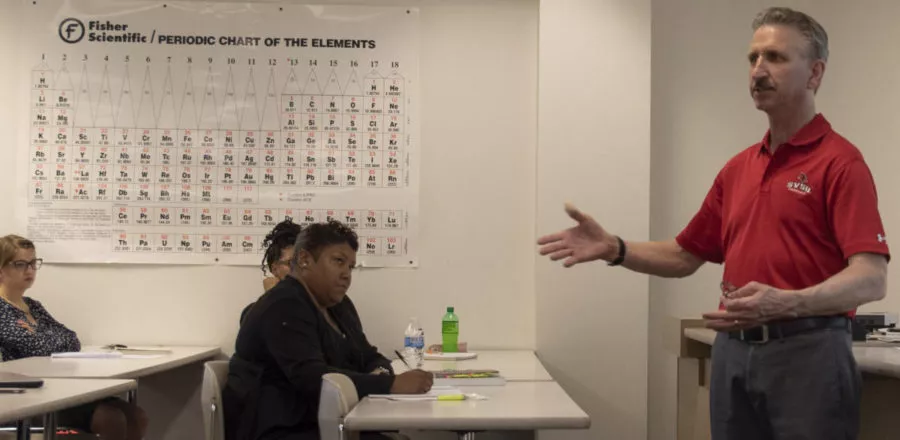 Saginaw Valley State University (SVSU) professor David Schneider was Googling a paper he recently published when he stumbled across a website where students rate their professors.
Saginaw Valley State University (SVSU) professor David Schneider was Googling a paper he recently published when he stumbled across a website where students rate their professors.
“I read the first five reviews, and honestly I have a lot of issues with ‘rate my professor,’ but it was spot on!” says Schneider. “‘Tough grader,’ ‘challenging,’ but they also view me as approachable, as caring, and they really enjoy my classroom experience.”
Schneider’s student-centered approach also inspires his NEA Higher Ed colleagues, who selected him as the 2019 Higher Educator of the Year. On Saturday, alongside the national Teacher of the Year and NEA Education Support Professional (ESP) of the Year, the NEA Representative Assembly (RA) honored Schneider.
“It’s been a humbling and moving experience to be recognized in this way,” says Schneider.
Although Schneider was unable to attend the annual meeting, National Council for Higher Education (NCHE) President DeWayne Sheaffer spoke on his behalf. “Our honoree, David, exemplifies so much of what is best in our profession. He has improved the college experience of students through his student-centered learning and research methods. He’s applied those learnings to his own classes and campus, but also shared his knowledge at national conferences. He’s a trailblazer, helping to challenge his peers.”
Schneider, a professor of communications and union leader who is entering his 34th year at SVSU, also has served as president of his local union, and as president and board member of the Michigan Association of Higher Education. “His message has been that the community benefits by strong cooperation and support,” writes his Michigan colleague Colleen Pilgrim, of Schoolcraft College, who nominated Schneider this year.
Focusing on student success
“It’s kind of interesting, in K12 education, ‘retention’ isn’t necessarily a positive word,” says Schneider. “But in higher education, it is! Our issue is trying to keep students in college, moving toward graduation.”
At SVSU, “for many very good reasons, less than 50 percent of our students will graduate in six years or less,” says Schneider. While poor academic preparation often is blamed, “it’s not the whole picture,” he adds. “The research reveals that students need to develop a sense of belonging on their new institutions, and there are things that faculty and staff can do to help.”
 Adults “attach” themselves in different ways, says Schneider. Psychologists talk about four attachment styles, such as “secure” or “dismissive” styles. “It may help students when faculty and staff identify the different ways that students attach, and offer them different kinds of connections,” says Schneider.
Adults “attach” themselves in different ways, says Schneider. Psychologists talk about four attachment styles, such as “secure” or “dismissive” styles. “It may help students when faculty and staff identify the different ways that students attach, and offer them different kinds of connections,” says Schneider.
“From my experience, we have all sorts of help centers on university campuses—writing centers, tutoring centers—but the students who need them most, use them the least! Faculty have the power of suggestion, or the power to integrate some of these services into our assignments, to help students realize these are good places to go,” says Schneider. “They’ll see that ‘I’m not going there because I’m weak, I’m going there because I’m smart!’”
Union leadership
Schneider has been a chief negotiator for his local NEA-affiliated faculty union since 1996, and he “understands the fight,” he says.
But he also sees his role at the bargaining table—and the role of the faculty union at large—as being bigger than faculty salary and benefits. “We, as union, need to remember that we organize around a skill. As long as we keep on top of that skill, many of the other battles don’t go away, but they become easier to deal with,” says Schneider. “It’s my belief that we need to create strong faculty—and strong faculty teach well, strong faculty do research, and strong faculty participate in college or university governance. Our training of our members should reflect that.”
“To me, good unionism is continually keeping an eye on and honing our professional skills,” he says.
On his campus, which respects the long-held principal of “shared governance,” union members have equal say in matters of curriculum and academic program development. Faculty understand that the union gives them a seat at the table.
Still, Schneider sees challenges in higher education today. When he attended college decades ago, the state of Michigan covered three-quarters of the cost, while students shouldered about one-quarter of the tuition burden. Today, the proportion is reversed: the state pays about one-quarter of the cost, while student tuition has skyrocketed to cover the balance. Struggling students and families incur enormous student debt.
That dynamic may contribute to students, families, and policymakers reconsidering the value of higher education in a way that concerns Schneider. Instead of thinking about the role of higher education in developing people who can think for themselves, and who can participate fully in their communities, it’s become more about job training. “College is an experience, not job training. Job training is something we do, but it’s not all we do,” he says.
The role of personal technology in classrooms: Curious about the paper that Schneider was Googling? It’s a review of the literature around the use of personal technology—like iPhones—in classrooms. (Read it here.) Not surprisingly, he found that the use of personal devices to text, or pop onto Facebook, or what Schneider calls “unstructured use” does “significant damage to academic performance.” Meanwhile, students who only use their devices for classroom-related tasks perform better. On the first day of class every semester, Schneider reviews the research with his students and they write a “limited-use technology policy” that allow students to use technology to take notes, or access their textbook or classroom website.


